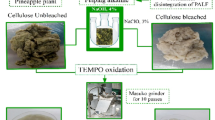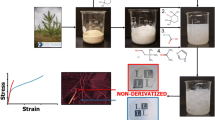Abstract
The residual cellulose of wood processing waste, sawdust, which was leftover after sequential hot-water extraction processes to isolate hemicelluloses and lignin in a novel forest biorefinery concept, was explored as the starting material for preparation of a highly value-added polymeric material, nanofibrillated cellulose (NFC) also widely termed as cellulose nanofiber, which has provided an alternative efficient way to upgrade sawdust waste. The residual cellulose in sawdust was converted to a transparent NFC suspension in water through the 2,2,6,6-tetramethylpiperidine-1-oxyl radical/NaClO/NaBr oxidization approach. The resultant NFC with a dimension of ca. 5 nm in width and hundreds of nanometers in length were further processed into NFC films. The morphological features of the NFC suspension and its films were assessed by transmission electron microscopy and scanning electron microscopy. Highly even dispersion of NFC fibrils in the films originated from sawdust feasibly contributes to the outstanding mechanical performance of the films. NFC suspension with higher carboxylate content and its resultant NFC films were found to show higher transmission of light.





Similar content being viewed by others
References
Abdul Khalil HPS, Bhat AH, Ireana Yusra AF (2012) Green composites from sustainable cellulose nanofibrils: a review. Carbohydr Polym 87(2):963–979
Abe K, Iwamoto S, Yano H (2007) Obtaining cellulose nanofibers with a uniform width of 15 nm from wood. Biomacromolecules 8(10):3276–3278
Araki J, Wada M, Kuga S (2001) Steric stabilization of a cellulose microcrystal suspension by poly(ethylene glycol) grafting. Langmuir 17(1):21–27
Benhamou K, Dufresne A, Magninc A, Mortha G, Kaddami H (2014) Control of size and viscoelastic properties of nanofibrillated cellulose from palm tree by varying the TEMPO-mediated oxidation time. Carbohydr Polym 99:74–83
Blot WJ (1997) Wood dust and nasal cancer risk. A review of the evidence from North America. J Occup Environ Med 39(2):148–156
Borrega M, Tolonen LK, Bardot F, Testova L, Sixta H (2012) Potential of hot water extraction of birch wood to produce high-purity dissolving pulp after alkaline pulping. Bioresour Technol 135:665–671
Cranston ED, Gray DG (2008) Birefringence in spin-coated films containing cellulose nanocrystals. Colloids Surf A 325(1–2):44–51
Dalmas F, Cavaillé JY, Gauthier C, Chazeau L, Dendievel R (2007) Viscoelastic behavior and electrical properties of flexible nanofiber filled polymer nanocomposites. Influence of processing conditions. Compos Sci Technol 67(5):829–839
Demers PA, Boffetta P, Kogevinas M, Blair A, Miller BA, Robinson CF, Roscoe RJ, Winter PD, Colin D, Matos E, Vainio H (1995) Pooled reanalysis of cancer mortality among five cohorts of workers in wood-related industries. Scand J Work Environ Health 21(3):179–190
Ebringerová A, Hromádková Z, Hříbalová V, Xu CL, Holmbom B, Sundberg A, Willför S (2008) Norway spruce galactoglucomannans exhibiting immunomodulating and radical-scavenging activities. Int J Biol Macromol 42(1):1–5
Eurostat (2013) http://epp.eurostat.ec.europa.eu/portal/page/portal/forestry/introduction. Accessed Jan 2013
Evans R, Wallis AFA (1989) Cellulose molecular weight determined by viscosity. J Appl Polym Sci 37:2331–2340
FitzPatrick M, Champagne P, Cunningham MF, Whitney RA (2010) A biorefinery processing perspective: treatment of lignocellulosic materials for the production of value-added products. Bioresour Technol 101(23):8915–8922
Fukuzumi H, Saito T, Isogai A (2012) Influence of TEMPO-oxidized cellulose nanofibril length on film properties. Carbohydr Polym 93(1):172–177
Klemm D, Kramer F, Moritz S, Lindstrom T, Ankerfors M, Gray D, Dorris A (2011) Nanocelluloses: a new family of nature-based materials. Angew Chem Int Ed 50(24):5438–5466
Liu AD, Berglund LA (2012) Clay nanopaper composites of nacre-like structure based on montmorrilonite and cellulose nanofibers—improvements due to chitosan addition. Carbohydr Polym 87(1):53–60
Liu J, Hu HR, Xu JF, Wen YB (2012a) Optimizing enzymatic pretreatment of recycled fiber to improve its draining ability using response surface methodology. BioResources 7(2):2121–2140
Liu SJ, Lu HF, Hu RF, Shupe A, Lin L, Liang B (2012b) A sustainable woody biomass biorefinery. Biotechnol Adv 30(4):785–810
Loureiro PEG, Domingues EF, Evtuguin DV, Graça Videira Sousa Carvalho M (2010) ECF bleaching with a final hydrogen peroxide stage: impact on the chemical composition of eucalyptus globulus kraft pulps. BioResources 5(4):2567–2580
Mikkonen KS, Stevanic J, Joly C, Dole P, Pirkkalainen K, Serimaa R, Salmén L, Tenkanen M (2011) Composite films from spruce galactoglucomannans with microfibrillated spruce wood cellulose. Cellulose 18(3):713–726
Mikkonen KS, Pitkänen L, Liljeström V, Bergström EM, Serimaa R, Salmén L, Tenkanen M (2012a) Arabinoxylan structure affects the reinforcement of films by microfibrillated cellulose. Cellulose 19(2):467–480
Mikkonen KS, Heikkilä M, Willför S, Tenkanen M (2012b) Films from glyoxal-crosslinked spruce galactoglucomannans plasticized with sorbitol. Int J Polym Sci. doi:10.1155/2012/482810
Nechwatal A, Mieck KP, Reusmann T (2003) Developments in the characterization of natural fibre properties and in the use of natural fibres for composites. Compos Sci Technol 63(9):1273–1279
Ohara H (2003) Biorefinery. Appl Microbiol Biotechnol 62(5–6):474–477
Okita Y, Saito T, Isogai A (2009) TEMPO-mediated oxidation of softwood thermomechanical pulp. Holzforschung 63(5):529–535
Saito T, Isogai A (2004) TEMPO-medoated oxidation of native cellulose. The effect of oxidation conditions on chemical and crystal structures of the water-insoluble fractions. Biomacromolecules 5(5):1983–1989
Saito T, Kimura S, Nishiyama Y, Isogai A (2007) Cellulose nanofibers prepared by TEMPO-mediated oxidation of native cellulose. Biomacromolecules 8(8):2485–2491
Saito T, Hirota M, Tamura N, Kimura S, Fukuzumi H, Heux L, Isogai A (2009) Individualization of nanosized plant cellulose fibrils by direct surface carboxylation using TEMPO catalyst under neutral conditions. Biomacromolecules 10(7):1992–1996
Siqueira G, Bras J, Dufresne A (2010) Cellulosic bionanocomposites: a review of preparation, properties and applications. Polymers 2(4):728–765
Song T, Pranovich A, Holmbom B (2011) Effects of pH control with phthalate buffers on hot-water extraction of hemicelluloses from spruce wood. Bioresour Technol 102(22):10518–10523
Tatrai E, Adamis Z, Bohm U, Meretey K, Ungvary G (1995) Role of cellulose in wood dust-induced fibrosing alveo-bronchiolitis in rat. J Appl Toxicol 15(1):45–48
Weber S, Kullman G, Petsonk E, Jones WG, Olenchock S, Sorenson W, Parker J, Marcelo-Baciu R, Frazer D, Castranova V (1993) Organic dust exposures from compost handling: case presentation and respiratory exposure assessment. Am J Ind Med 24(4):365–374
Zakzeski J, Bruijnincx PCA, Jongerius AL, Weckhuysen BM (2010) The catalytic valorization of lignin for the production of renewable chemicals. Chem Rev 110(6):3552–3599
Acknowledgments
The authors would like to acknowledge the financial support of the China Scholarship Council. We thank Dr. Jan Gustafsson for access to the FiberLab instrument. Prof. Maija Tenkanen at the University of Helsinki is gratefully acknowledged for valuable discussions. Chunlin Xu also thanks the Knut and Alice Wallenberg Foundation for financial support via the KTH Wallenberg Wood Science Center. This work was also part of the activities at the Åbo Akademi Process Chemistry Centre.
Author information
Authors and Affiliations
Corresponding author
Electronic supplementary material
Below is the link to the electronic supplementary material.
Rights and permissions
About this article
Cite this article
Liu, J., Korpinen, R., Mikkonen, K.S. et al. Nanofibrillated cellulose originated from birch sawdust after sequential extractions: a promising polymeric material from waste to films. Cellulose 21, 2587–2598 (2014). https://doi.org/10.1007/s10570-014-0321-4
Received:
Accepted:
Published:
Issue Date:
DOI: https://doi.org/10.1007/s10570-014-0321-4




